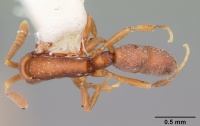Probolomyrmex guanacastensis
| Probolomyrmex guanacastensis | |
|---|---|

| |
| Scientific classification | |
| Kingdom: | Animalia |
| Phylum: | Arthropoda |
| Class: | Insecta |
| Order: | Hymenoptera |
| Family: | Formicidae |
| Subfamily: | Proceratiinae |
| Tribe: | Probolomyrmecini |
| Genus: | Probolomyrmex |
| Species: | P. guanacastensis |
| Binomial name | |
| Probolomyrmex guanacastensis O'Keefe & Agosti, 1998 | |
This species is only known from a single collection of two specimens.
| At a Glance | • Ergatoid queen |
Identification
Oliveira & Feitosa (2019) - Postero-ventral lobe of petiole short and rounded. Subpetiolar process weakly developed. First gastral segment with prora and a dorsal protuberance on the posterior region of gaster.
This species is easily separated from Probolomyrmex petiolatus by the shape of the petiolar process, and from Probolomyrmex boliviensis by the smaller size, shorter scape, lack of a gastral collar, and similar coloration of the petiolar process and tergite. The ergatoid female has eyes and ocelli, but flight sclerites are not developed. This species is phenotypically very similar to Probolomyrmex brujitae, but differs in having a relatively larger head and longer scape.
Keys including this Species
Distribution
Distribution based on Regional Taxon Lists
Neotropical Region: Costa Rica (type locality).
Distribution based on AntMaps
Distribution based on AntWeb specimens
Check data from AntWeb
Countries Occupied
| Number of countries occupied by this species based on AntWiki Regional Taxon Lists. In general, fewer countries occupied indicates a narrower range, while more countries indicates a more widespread species. |

|
Estimated Abundance
| Relative abundance based on number of AntMaps records per species (this species within the purple bar). Fewer records (to the left) indicates a less abundant/encountered species while more records (to the right) indicates more abundant/encountered species. |

|
Biology
More collections are needed to confirm the presence of ergatoids in this species. It is possible the paratype was a worker that aberrantly developed eyes and ocelli.
O'Keefe and Agosti (1997) - The specimens (type material) were found in sifted debris processed through a modified Berlese-Tulgren funnel from a riparian habitat that included Ochroma pyramidale, Albizzia samen, Anacardium excelsum, Ceiba pentadra, Hymenia courbaril, Bursera simiruba, Andira inermis, Spondias mombin, Sweetenia macrophylla, Cedrela odorata, Enterolobium cyclocarpum, Hirtella racemosa, and Ardesia revoluta. The paratype represents the first record of an ergatoid female in this genus. All other known sexuals of Probolomyrmex are of the normal winged type (Taylor, 1965). Ergatoids typically occur in species with large colonies (Peeters, 1997) but it is believed that colony size is small in this genus. The only colony collection contained less than 30 individuals.
Castes
The ergatoid female has eyes and ocelli, unlike workers (O'Keefe & Agosti 1997). Body sizes are very similar.
Images from AntWeb

| |
| Paratype of Probolomyrmex guanacastensis. Queen (ergatoid). Specimen code casent0104673. Photographer April Nobile, uploaded by California Academy of Sciences. | Owned by AMNH, New York, NY, USA. |
Nomenclature
The following information is derived from Barry Bolton's Online Catalogue of the Ants of the World.
- guanacastensis. Probolomyrmex guanacastensis O'Keefe & Agosti, 1998: 191, figs. 1-4 (w. ergatoid q.) COSTA RICA.
- Type-material: holotype worker, 1 paratype ergatoid queen.
- Type-locality: holotype Costa Rica: Guanacaste, 8.5 km. NW Bagaces, Plazuela Hacienda Monteverde, 31.viii.1996, sifted leaf debris (S. O’Keefe); paratype with same data.
- Type-depositories: INBC (holotype); AMNH (paratype).
- Status as species: Oliveira & Feitosa, 2019: 80 (redescription).
- Distribution: Costa Rica.
Unless otherwise noted the text for the remainder of this section is reported from the publication that includes the original description.
Description
Worker
HL 0.65, HW 0.39, SL 0.41, TL 0.79, CI 0.60, SI 106, (1 examined).
Oliveira & Feitosa (2019) - Similar to ergatoid queen, except by the absence of eyes and ocelli.
Queen
Oliveira & Feitosa (2019) - Ergatoid (from original description): (n=1) HL 0.63; HW 0.41; SL 0.40; WL 0.81; CI 65; SI 63.5.
Ergatoid description: Head 1.6 times longer than wide. Antennal scapes extends beyond head midlength, distance from scape apex to of head more than two times pedicel length (SI 63.5). Compound eyes and three equally sized ocelli present. Propodeal declivity laterally with narrow carina, dorsolateral teeth present, almost in same plane as dorsal profile of the propodeum in lateral view. Petiole longer than high, without teeth; anterior face of petiolar node long and inclined; posterior face short and concave; postero-ventral lobe short and rounded; subpetiolar process weakly developed. First gastral segment with prora and dorsal protuberance on posterior region of tergite, characterized by gentle elevation of the integument.
Type Material
- Holotype: COSTA RICA: Guanacaste, 8.5 km NW Bagaces: Plazuela Hacienda Monteverde, 31.viii.1996, S. O’Keefe, sift leaf debris (worker) American Museum of Natural History.
- Paratype: same data as holotype, except: 1 ergatoid queen, American Museum of Natural History (see www.antweb.org; specimen CASENT0104673).
References
- O'Keefe, S. T.; Agosti, D. 1997. A new species of Probolomyrmex (Hymenoptera: Formicidae) from Guanacaste, Costa Rica. J. N. Y. Entomol. Soc. 105: 190-192.
- Oliveira, A.M., Feitosa, R.M. 2019. Taxonomic revision of the genus Probolomyrmex Mayr, 1901 (Hymenoptera: Formicidae: Proceratiinae) for the Neotropical Region. Zootaxa 4614 (1): 61–94 (doi:10.11646/zootaxa.4614.1.3).
References based on Global Ant Biodiversity Informatics
- Nascimento I. C., J. H. C. Delabie, S. Campiolo,and E. M. Neto. 2004. Présence de Probolomyrmex brujitae Agosti, 1994, au Brésil (Hym., Formicidae). Bull. Soc. Entomol. Fr. 109(3): 321-322.
- Oliveira A. M., and R. M. Feitosa. 2019. Taxonomic revision of the genus Probolomyrmex Mayr, 1901 (Hymenoptera: Formicidae: Proceratiinae) for the Neotropical Region. Zootaxa 4614: 61–94.

